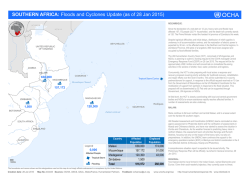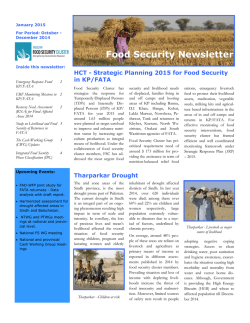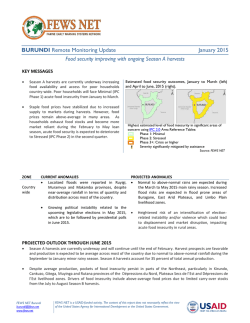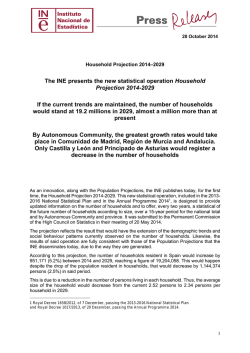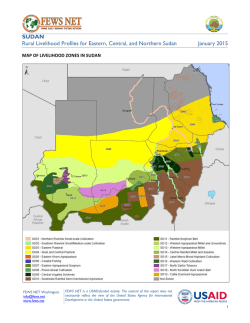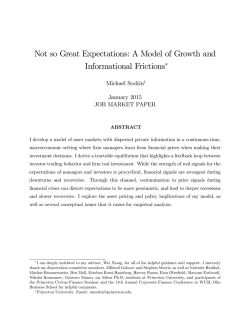
KENYA Food Security Outlook January to June 2015 Below
Government of Kenya KENYA Food Security Outlook January to June 2015 Below-average short rains to heighten food insecurity in pastoral and marginal agricultural areas Current food security outcomes, January 2015 KEY MESSAGES The October to December 2014 short rains were well below average, which caused food insecurity in the Southeast, the coastal lowlands, and pastoral areas. Over the next several months, the food insecure population is expected to increase to over 1.5 million people. The short rains were well below average and concentrated in November with very little rain in October or December in the southeastern and coastal marginal agricultural lowlands. This is likely to result in a far below average harvest, and an increase in the number of people who are food insecure. The majority of households are expected to remain Stressed (IPC Phase 2) through June. In the northern pastoral areas, the performance of the Source: FEWS NET rains was poor and did not support significant increases in This map represents acute food insecurity outcomes relevant for livestock production. Rangeland conditions are expected emergency decision-making. It does not necessarily reflect chronic to deteriorate faster than normal during the January to food insecurity. To learn more about this scale, click here. March short dry season. The majority of households will remain Stressed (IPC Phase 2), but the areas that had the least rainfall are likely between now and March to remain in Crisis (IPC Phase 3), including Sericho and Merti Sub-counties in Isiolo, Daadab and Balambala Sub-counties in Garissa, and Hadado and Sebule Sub-counties in Wajir. SEASONAL CALENDAR FOR A TYPICAL YEAR Source: FEWS NET FEWS NET KENYA [email protected] www.fews.net/Kenya FEWS NET is a USAID-funded activity. The content of this report does not necessarily reflect the view of the United States Agency for International Development or the United States Government KENYA Food Security Outlook NATIONAL OVERVIEW January to June 2015 Projected food security outcomes, January to March 2015 Current Situation Outside of the marginal agricultural and pastoral areas, food security has remained fairly stable. The High and Medium Rainfall Areas Food Situation Assessment Report published in November 2014 notes that despite the highly uneven distribution of the March to August long rains with many areas receiving well below average rainfall, maize production was still near average. Production of other crops was more than last year, including bananas, root crops, vegetables, fruit, and rice. The National Cereals and Produce Board (NCBP) is currently purchasing maize from farmers in the high- and mediumpotential areas for the Strategic Grain Reserve. Most markets are functioning normally with adequate maize available at stable prices. Between November and December, wholesale maize prices in Nairobi and Eldoret declined up to eight percent, but they were fairly stable in Mombasa and Kisumu. December prices in Nairobi, Mombasa, and Eldoret are up to 20 percent below the five-year average, but they were 11 percent above the five-year average in Kisumu. Stable or declining maize prices are due to ample supplies in the market both from increased imports from neighboring countries and from the continued long rains harvest. The Food Security and Nutrition Working Group’s (FSNWG’s) East Africa Cross-Border Trade Bulletin for January 2015 noted that 2014 maize imports from Tanzania and Uganda were 21 and 16 percent higher than 2013, respectively. Stable macroeconomic conditions, including the recent reduction of general consumer inflation, have also helped keep maize prices stable. Overall, the inflation rate decreased 10 percent between September and December 2014. Source: FEWS NET Projected food security outcomes, April to June 2015 Source: FEWS NET In the marginal agricultural, agropastoral, and pastoral areas, the number of food insecure households is rising, primarily due This map represents acute food insecurity outcomes relevant for to the October to December short rains being well below emergency decision-making. It does not necessarily reflect chronic food insecurity. To learn more about this scale, click here. average, being the third consecutive rainy season of belowaverage rainfall in many areas. The southeastern marginal agricultural areas are likely to have very low production, and the short rains harvest typically provides a large proportion of annual food needs. In the southeastern and parts of the coastal marginal agricultural areas, especially Taita Taveta, short-cycle legumes were not available in late December or early January. These crops would be typically the dominant source of food and income at this time of year. Preliminary reports from the Ministry of Agriculture indicate that the short rains crop may be 40 to 50 percent below average in volume. Household stocks from the long rains harvest in July were depleted by September when normally they would last into November. Households have needed to purchase food for much of the past year with little of their own production. Due to the reduced size of the harvest and poor performance of the crops, it has been difficult for households to find on-farm, casual labor opportunities, reducing a key source of household income. However, stable food prices have allowed many households to continue to purchase food. Households have been trying to expand their incomes using charcoal burning, credit purchase, sand harvesting, petty trade, and remittances, among other strategies. These households are still able to access adequate quantities of food and are currently Stressed (IPC Phase 2). In pastoral areas, dry conditions led to early livestock migration. This has left household members who did not migrate with the livestock without access to milk and other livestock products. In some areas, there has been conflict over resources due to migration. Deteriorating rangeland conditions have already led to deterioration in livestock body conditions. Livestock Famine Early Warning Systems Network 2 KENYA Food Security Outlook January to June 2015 prices remained fairly stable from November to December. With limited income and low availability of livestock products, household food consumption remains constrained. Many households are trying to expand their incomes to buy more food. They are purchasing food on credit, burning charcoal, and using other strategies. Most pastoral areas remain Stressed (IPC Phase 2), but localized areas in Wajir, Isiolo, and Garissa are in Crisis (IPC Phase 3) due to these areas having worse conditions for livestock production. Assumptions The following assumptions have been made at the national level: The March to May long rains are expected to start on time, have typical spatial and temporal distribution, and have nearaverage cumulative rainfall. Rangeland resources are expected to deteriorate faster than normal during the January to March dry season, due to the low rainfall during the last season, the early end of those rains, and the likely warmer-than-normal temperatures during the dry season. Continued importation of maize from Uganda and Tanzania is expected through June. Maize prices are expected to marginally increase from January through June though ample supplies will ensure price increases are not unseasonable or particularly large. Between January and March during the dry season, land surface temperatures are likely to be higher than average. Heat waves and dust storms will be more likely than usual, especially in the northern parts of the country. Fuel prices are expected to continue decreasing through April, driven by the expected continued fall in international crude oil prices. Declining fuel prices are expected to drive transportation and energy costs down, eventually further reducing the consumer inflation rate. Prices of a broad range of products are likely to fall, increasing household purchasing power. Humanitarian assistance by the national government, county governments, and other agencies is expected to increase and widen in scope between January and June as agencies respond to increasing needs. Most Likely Food Security Outcomes With the remaining long rains harvest, the expected short rains harvest, stocks, and maize imports from Tanzania and Uganda, the Ministry of Agriculture estimates that maize stocks should last through at least June 2015. The maize balance sheet projected from January 1 to June 30 estimated that the country would have adequate maize supplywith a surplus of 60,000 metric tons (MT) after June. While maize stocks will remain at the national level, households stocks in the high- and mediumpotential areas are expected to diminish as households sell maize to purchase other foods, cover other expenses, and buy agricultural inputs at the start of the long rains season in March. With the start of the long rains season expected to be on time, households should continue to be able to access agricultural labor opportunities and conduct other agricultural activities like land preparation, planting, and weeding in a normal manner. In pastoral areas, households are likely to become more food insecure from January to March, especially in the Northeast in Wajir, Isiolo, Garissa, parts of Mandera, Samburu, and Marsabit Counties. Livestock body conditions and health are expected to continue deteriorating, exacerbated by the warmer than normal temperatures from January to March during the dry season. Distances between water sources and grazing areas are expected to further increase, leading to increasingly long daily treks for livestock and longer distances to collect water for household consumption. Continued migration of livestock to dry season grazing areas is expected, but migration options are likely to be limited with similarly dry conditions across most areas. However, cross-border migration to neighbouring areas in Somalia and Uganda are expected from Garissa, Wajir, and Turkana Counties. Livestock prices are expected to continue decreasing, resulting in a further declines in income and purchasing power. As a result, livestock-to-cereal terms of trade are expected to further decrease, limiting households’ access to food. Malnutrition rates will start to rise, especially in Garissa, Isiolo, Wajir, parts of Mandera, Marsabit, and Samburu. After the start of the long rains in April, rangeland conditions will improve, and livestock body conditions will start to recover. The majority of households will remain Stressed (IPC Phase 2), but some poor pastoral households in parts of Wajir, Isiolo, and Garissa are likely to remain in Crisis (IPC Phase 3) through April and to move to Stressed (IPC Phase 2) after that in June. Famine Early Warning Systems Network 3 KENYA Food Security Outlook January to June 2015 For the southeastern and coastal marginal agricultural areas, the short rains harvest in February/March will likely be below average. With little income, many households may consume less food, especially in areas around Mbeere South in Embu County and Mwingi North in Kitui County between January and March. Once the long rains start, household income will seasonally increase a bit from labor for land preparation and planting. While the long rains are not the principal season in these areas, and given that households have few if any food stocks, it is anticipated that a large proportion of households will plant in an attempt to compensate for the very low production from the previous season. Fresh legumes may be available as early as April, so legume sales and agricultural labor will support market purchases at that time, increasing household food access. Improvements in household food consumption are expected between April and June as more short-cycle crops become available. These areas are likely to remain Stressed (IPC Phase 2) through at least June. AREAS OF CONCERN Southeastern Marginal Mixed Farming livelihood zone Current Situation Following the well below average short rains, which were poorly distributed, agricultural labor demand was below average, and crops failed to fully develop. A significant proportion of households were not able to find on-farm casual labor opportunities, reducing their incomes. Normally by now, there would be some access to short-cycle crops and green consumption, but this year, there are very few short-cycle crops that fully matured. However, stable staple food prices in most markets have preserved some household purchasing power. Retail maize prices remained fairly stable between November and December across the Southeast. Maize prices were 14 and 12 percent above their five-year averages in Embu and Nyeri, respectively, but they remained close to their averages in Kitui, Makueni, Tharaka Nithi, and Meru. Imports from Tanzania and supplies from other parts of the country have kept prices stable. Right now, there is some harvesting of maize and the more drought-resistant crops such as cowpeas and green grams (mung beans), but primarily by farmers who planted earlier in September. The majority who planted at the start of the short rains have few, if any, crops to harvest. Water availability is rapidly declining, though water is still available. As a result, water prices have increased. Livestock trekking distances remain within normal ranges, at between two and five kilometers (km). Pasture and browse conditions for livestock did improve during the short rains, supporting some livestock productivity. Despite conditions for livestock production being more favorable to households than those for crop production right now, the poor own a very low number of livestock, so they do not receive much food or income from livestock. Increasingly, households are trying to make more money to buy food by burning charcoal, gathering firewood, or harvesting sand. They are also relying more on credit purchases to meet their food needs. Also, many households are supplementing their income with petty trade and remittances. Using a variety of coping mechanisms, the majority of the marginal agricultural households are still able to purchase minimally adequate quantities of food and remain Stressed (IPC Phase 2). Assumptions In addition to the national assumptions made above, the following additional assumptions have been made for the Southeastern Marginal Mixed Farming livelihood zone: The short rains harvest in February/March is expected to be below average. After the start of the long rains in March, greater area than usual will be planted with maize and other crops. Demand for agricultural, casual labor will be well below average in February and March due to the small harvest, but it will increase more than seasonally after March for long rains land preparation, planting, and weeding. Remittances from labor migrants to rural households are expected to increase between now and June. Between now and June, households will intensify their use of coping strategies including charcoal burning, firewood gathering, intensifying petty trade, and sand harvesting to generate income to purchase food. It is expected that humanitarian interventions will continue and be expanded in these areas. For example, food for assets (FFA) is already programmed to continue in many areas through June, and additional programs will likely be compliment it over the coming months. Famine Early Warning Systems Network 4 KENYA Food Security Outlook January to June 2015 Most Likely Food Security Outcomes The southeastern marginal agricultural areas in Kitui, Makueni, Tharaka Nithi, Mbeere, Nyeri, and northern Meru County are likely to see crop failure in large areas with production estimated to be 40 to 50 percent below average overall. Households in a typical year get up to 70 percent of their own produced food from the short-rains harvest. With the third consecutive far below average short rains harvest, food insecurity is likely to deepen for a significant proportion of the population. With very low food stocks due to the very small maize harvest in February, households will need to purchase food from markets throughout 2015. Over the course of the dry season, more water points are likely to dry up, forcing some households to start going farther distances for water for household and livestock use. Below-average household income between January and March is likely to constrain market purchases for the majority of poor households, limiting household food consumption. Food security is likely to remain Stressed (IPC Phase 2) through March 2015. However, on-farm casual labor opportunities will start to become available in March, as households increase planting of long rains crops compared to a typical year, as a way to compensate for crop and income losses earlier. From April to June, marginal improvements in food security are expected, but only if the coming long rains are near average in amount and have a normally timed start. Though the coming long rains season is not the dominant season, in previous years with very low short rains production, households increased crop production during the long rains. That is likely to happen this year. Agricultural, casual labor demand will likely be higher than average, increasing household incomes, and coupled with sale of legumes, support some market purchases. However, if the rains were to start very late or be significantly below average in amount, household food security would not improve after April. Poor households who already have had large losses of income would be likely to become highly food insecure after April with little access to food or income and move into Crisis (IPC Phase 3), most likely in Mbeere South in Embu County and Kitui North in Kitui County. However, even in that case, the majority of households would be expected to remain Stressed (IPC Phase 2) through June. In the most likely scenario with a normally timed start of the long rains and resulting increases in income and food access, most households will remain Stressed (IPC Phase 2) between April and June. Pastoral livelihood zones Current Situation In most of the pastoral livelihood zones, the short rains stopped early in late November, as opposed to a more normal ending in early to mid-December. However, in the northwestern pastoral areas in Turkana, Samburu, and parts of Marsabit, West Pokot, and Baringo Counties, there were off-season rains in September that normally do not occur, then there was more rain than in other areas. This led to rangeland conditions being fair to good, though they are already deteriorating with the start of the dry season. Livestock body conditions also range from fair to good, as livestock productivity and prices increased between October and December. In contrast, most of the northeastern pastoral areas received far below average rainfall, except for Mandera County where there was more rainfall. Rangeland resources did not regenerate as much as they do in a typical year. Water, pasture, and browse are less available than usual across most pastoral areas. Rangeland conditions have been reported to be poor in Isiolo, Garissa, Wajir, Kajiado, eastern Marsabit, and in Tana River County. According to the National Drought Management Authority (NDMA), the deterioration of rangeland conditions has already reduced livestock productivity. In most areas, distances to water points for households and livestock have increased. Livestock trekking distances have increased 10 to 40 percent in most areas and even more in Garissa. Livestock out-migration has been reported in some of the counties, with some out-migration of livestock to Somalia from Garissa and Wajir. Out-migration has also occurred from Isiolo and Marsabit. With limited resources, there have been reported cases of clashes between groups of pastoralists in Garissa, Isiolo, Turkana, Samburu, and Marsabit. Despite the on-going deterioration of rangeland conditions, livestock body conditions, especially for goats, still remain fair to average, so livestock prices remain mostly stable. Livestock prices remained stable between November and December in Turkana, Kajiado, Marsabit, Narok, Samburu, Wajir, Mandera, Garissa, and Baringo, but increased up to 12 percent in West Pokot and Isiolo. Livestock prices were six to 25 percent above their five-year averages, except in Mandera and Isiolo where they were up to 22 percent below their five-year averages. Insecurity in Mandera County has likely reduced demand and Famine Early Warning Systems Network 5 KENYA Food Security Outlook January to June 2015 driven lower prices, and in Isiolo, poor livestock body conditions may be the cause of lower prices. In the majority of areas, the stability in livestock prices was, in part, due to seasonally high demand for livestock during December. Similarly, retail staple food prices remained stable between November and December, except in Turkana and West Pokot where there were cereal price increases of up to 10 percent. Continuous inflow of staple foods from other regions has ensured steady market supply and stable prices. Terms of trade are still near or above average. Malnutrition, as measured by the proportion of children ‘at risk’ of malnutrition, defined as those with mid-upper arm circumference (MUAC) less than 135 millimeters (mm), increased from November to December by seven to 15 percent in Samburu and Wajir, respectively, but fell up to 20 percent in Isiolo, Mandera, and Turkana Counties. The proportion of children ‘at risk’ of malnutrition in most of these areas has remained below the five-year averages, probably due to ongoing supplementary nutrition programs. Most pastoral areas remain Stressed (IPC Phase 2). However, areas that had a very dry rainy season did not see the typical, seasonal increases in livestock production, and they are now in Crisis (IPC Phase 3), mainly in Wajir, Isiolo, and Garissa. Assumptions In addition to the national assumptions above, the following assumptions have been made about pastoral livelihood zones: With warmer than normal temperatures expected between January and March, rangeland conditions will deteriorate faster than usual. However, after March, the resumption of the rains is likely to lead to normal seasonal improvement of rangeland conditions. These will lead to increased livestock productivity. After the rains start, some calving, kidding, and lambing are expected between April and May, though the total number of livestock births will be below average, given fewer small ruminant conceptions than usual during the drier short rains. Humanitarian assistance is likely to continue to be provided through June in pastoral livelihood zones. The number of livestock being migrated is likely to continue to increase in January and February, up to a month earlier than normal from areas with poorer pasture and browse to areas with more pasture, browse, and water availability. Most Likely Food Security Outcomes Continued deterioration of rangeland conditions, possible outbreaks of contagious livestock diseases due to increased clustering of weakened livestock, conflicts over grazing resources, and deterioration in livestock-to-cereal terms of trade are all factors likely to lead to increasing food insecurity between January and March. The northeastern pastoral areas, especially Garissa, Isiolo, Wajir, parts of Mandera, and Tana River, are likely to be the worst affected, as they had the least rain during the October to December short rains. Warmer than average temperatures will lead to faster deterioration of rangeland conditions and declines in livestock productivity. Livestock products like milk will become less available. Livestock prices will fall, and households will have below-average incomes from livestock and livestock products. Livestock-to-cereal terms of trade are likely to decrease from January through April. Water availability will decrease through April, leading to increased water prices and further constraining household purchasing power. Households are likely to use poor quality or contaminated water, resulting in increased disease incidence, and subsequently, poor food utilization and an increasing number of malnutrition cases through March. With less income, household food consumption will be reduced. Though the majority of households will remain Stressed (IPC Phase 2), some poor pastoral households in parts of Wajir, Isiolo, and Garissa are likely to remain in Crisis (IPC Phase 3) through March. Following the start of the long rains in March, rangeland conditions will improve and by April, livestock body conditions will improve. Milk yields and birth rates are expected to be below normal, owing to low conception levels during the belowaverage short rains. Being a short dry season, limited livestock mortalities are expected at the onset of the long rains, as most of the livestock, especially in the Northwest, are expected to have fair body conditions and not necessarily be particularly susceptible to disease. With improved livestock productivity, households will access food through typical livelihood strategies like livestock sales, resulting in increased food consumption. The majority of households will be Stressed (IPC Phase 2) by June, including the areas that were in Crisis (IPC Phase 3) from January through March. Famine Early Warning Systems Network 6 KENYA Food Security Outlook January to June 2015 EVENTS THAT MIGHT CHANGE THE OUTLOOK Table 1: Possible events over the next six months that could change the most-likely scenario. Area Northern Pastoral livelihood zones Event Below-average total rainfall during the March to May long rains or a late start Northern Pastoral livelihood zones Northern Pastoral and Agropastoral livelihood zones Northern Pastoral livelihood zones Increased conflict Southeastern Marginal Mixed Farming livelihood zone Southeastern Marginal Mixed Farming livelihood zone High above average March to May long rains Impact on food security outcomes Lack of recovery of browse, pasture, and water availability would likely exacerbate the already poor livestock body conditions and low prices. With expected price increases of staple foods, purchasing power of households will be further eroded, worsening food security. Increased displacement and reduced market functioning would limit household food access. Flash floods after the onset of the long rains in March, in localized areas Displacement of households, loss of crops in agropastoral areas, losses of livestock, and losses of other assets High insecurity in the Northeast due to threats by cross-border militants As markets closed and access to grazing declined, income and livestock productivity would fall. This could also reduce access to the area for humanitarian and government agencies providing humanitarian assistance. Improved grazing conditions and improved livestock body conditions would likely follow. Increased crop production, including of perennial legumes such as pigeon peas, would also help increase both food access and incomes. Limited availability of perennial legumes, resulting in a further increase in the amount of food households needed to buy on markets would further strain already low household incomes. This could also lead to increased staple food prices, constraining food access. Far below average total rainfall during the March to May long rains or a late start ABOUT SCENARIO DEVELOPMENT To project food security outcomes, FEWS NET develops a set of assumptions about likely events, their effects, and the probable responses of various actors. FEWS NET analyzes these assumptions in the context of current conditions and local livelihoods to arrive at a most likely scenario for the coming six months. Learn more here. Famine Early Warning Systems Network 7
© Copyright 2026
